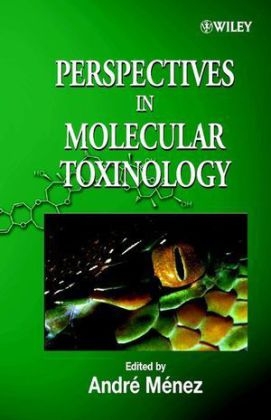
Perspectives in Molecular Toxinology
John Wiley & Sons Inc (Verlag)
978-0-471-49503-1 (ISBN)
- Titel z.Zt. nicht lieferbar
- Versandkostenfrei
- Auch auf Rechnung
- Artikel merken
Covering the most recent advances in our understanding of toxins from venomous animals and microbes as well as that of their targets, this book expertly addresses the many intriguing and unsolved questions concerning; proteomics studies of the "toxinome", intimate modes of toxin actions, molecular basis of specificity, pleiotropic properties of toxins and structural biology of toxins.
Through twenty-seven chapters the authors discuss the role of structural genomics in toxinology, how toxins are subject to accelerated evolution, how toxins can be exploited as models for the design of new drugs, and what the future holds for the treatment of snake bites.
In order to address these challenging aspects, the authors have posed crystal-clear questions. Based on the most precise knowledge the attendant reasoning shows how toxinology has become an important area of biochemistry and is directly associated with advances in cellular microbiology, molecular pharmacology, molecular physiology, cell biology, protein engineering and many other disciplines.
Andre Menez is the Director of the Department of Protein Engineering at the Commissariat a l'Energie Atomique (CEA) in France. He heads the Laboratory of Protein Chemistry and is Professor at the National Institute of Sciences and Nuclear Techniques.
List of Contributors
Preface
I TOXINS FROM MICROORGANISMS
Bacterial Toxins with Metalloprotease Activity (O. Rossetto and C. Montecucco)
The Cholesterol-dependent Cytolysins: Current Perspectives on Membrane Assembly and Insertion (E. Hotze and R.K. Tweten)
Toxin-producing Dinoflagellates (M.J. Holmes and R. Lewis)
Involvement of Na+ in the Actions of Ciguatoxins and Brevetoxins that Stimulate Neurotransmitter Release and Affect Synaptic Transmission (J. Molgó and E. Benoit)
II ANIMAL TOXINS AND NEW METHODOLOGIES
Role of Discovery Science in Toxicology: Examples in Venom Proteomics (J.W. Fox, J.D. Shannon, B. Stefansson, A.S. Kamiguti, R.D.G. Theakston, S.M.T. Serrano, A.C.M. Camargo and N. Sherman)
Proteomics of Venom Peptides (R. Stocklin and P. Favreau)
High-resolution NMR of Venom Toxins in Nanomolar Amounts (M. Delepierre)
III ANIMAL TOXINS: FROM FUNDAMENTAL STUDIES TO DRUGS?
Cone Snails and Conotoxins Evolving Sophisticated Neuropharmacology (B.M. Olivera, J.S. Imperial and G Bulaj)
Toxin Structure and Function: What Does Structural Genomics Have To Offer? (R.S. Norton)
The Sites by which Animal Toxins Bind to their Targets Involve Two Components: A Clue for Selectivity, Evolution and Design of Proteins? (A. Ménez, D. Servent and S. Gasparini)
Scorpion Genes and Peptides Specific for Potassium Channels: Structure,Function and Evolution (L.D. Possani, E. Merino, M. Corona and B. Becerril)
Scorpion Toxins Differentiating among Neuronal Sodium Channel Subtypes: Nature's Guide for Design of Selective Drugs (D. Gordon, N. Gilles, D. Bertrand, J. Molgó, G.M. Nicholson, M.P. Sauviat, E. Benoit, I. Shichor, I. Lotan, M. Gurevitz, R.G. Kallen and S.H. Heinemann)
Diversification of Toxic Sites on a Conserved Protein Scaffold - a Scorpion Recipe for Survival (M. Gurevitz, N. Zilberberg, O. Froy, M. Turkov, R. Wilunsky, I. Karbat, J. Anglister, B. Shaanan, M. Pelhate, M.E. Adams, N. Gilles, D. Gordon)
Methodological Approaches to the Study of Ion Channels Using Peptide Toxins: Proposed Comprehensive Guidelines (M. De Waard, J.-M. Sabatier and H. Rochat)
Toxins as Probes for Structure and Specificity of Synaptic Target Proteins (P. Taylor, B. Molles, S. Malany and H. Osaka)
Allosteric and Steric interactions of Polyamines and Polyamine-containing Toxins with Nicotinic Acetylcholine Receptors (T.J. Brier, I.R. Mellor and P.N.R. Usherwood)
Anabaseine as a Molecular Model for Design of a7 Nicotinic Receptor Agonist Drugs (W.R. Kem)
Understanding the Structure-Function Relationship of Snake Venom Cardiotoxins (T.K.S. Kumar, S. Srisailam, R.R. Vethanayagam and C. Yu)
Structure and Function of Disintegrins and C-lectins: Viper Venom Proteins Modulating Cell Adhesion (S. Niewiarowski, C. Marcinkiewicz, I. Wierzbicka-Patynowski, M.A. McLane and J.J. Calvete)
Prothrombin Activators from Snake Venoms (R.M. Kini, J.S. Joseph and V.S. Rao)
C-type Lectins from Snake Venoms: New Tools for Research in Thrombosis and Haemostasis (A. Wisner, M. Leduc and C. Bon)
Toxins Leading to Medicines (A.L. Harvey)
IV EVOLUTION OF ANIMAL TOXINS
Accelerated and Regional Evolution of Snake Venom Gland Isozymes (M. Ohno, T. Ogawa, N. Oda-Ueda, T. Chijiwa and S. Hattori)
Functional Diversification of Animal Toxins by Adaptive Evolution (D. Kordis, I. Kriûaj and F. Gubenëek)
V FROM VENOMS TO TREATMENT
The Venomous Function (M. Goyffon)
Are Inhibitors of Metalloproteinases, Phospholipases A2 and Myotoxins Members of the Innate System? (J. Perales and G.B. Domont)
The Treatment of Snake Bites: Analysis of Requirements and Assessment of Therapeutic Efficacy in Tropical Africa (J.-P. Chippaux)
| Verlagsort | New York |
|---|---|
| Sprache | englisch |
| Maße | 161 x 232 mm |
| Gewicht | 907 g |
| Einbandart | gebunden |
| Themenwelt | Studium ► 2. Studienabschnitt (Klinik) ► Pharmakologie / Toxikologie |
| Naturwissenschaften ► Biologie ► Biochemie | |
| Naturwissenschaften ► Biologie ► Mikrobiologie / Immunologie | |
| Naturwissenschaften ► Chemie | |
| ISBN-10 | 0-471-49503-4 / 0471495034 |
| ISBN-13 | 978-0-471-49503-1 / 9780471495031 |
| Zustand | Neuware |
| Haben Sie eine Frage zum Produkt? |
aus dem Bereich


